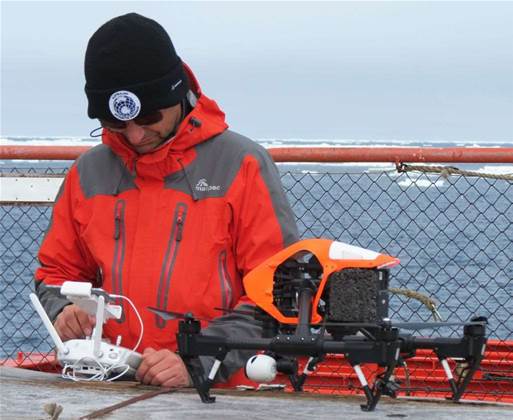Australia's Antarctic flagship deployed a quadcopter drone to help it make its way through the sea ice during its recent annual nine-day resupply trip to Casey station.

The unmanned aerial vehicle (UAV) gave the crew real-time imagery of the sea ice conditions up ahead, allowing them to make better decisions regarding navigation. The ship's crew partnered with local drone company Australian UAV for the proof of concept flights.
However, they discovered they were unable to fly the drone with the GPS enabled as its batteries did not operate properly in snow, nor did the drone's compass perform properly with the ship's thousands of tonnes of steel.
“Because the compass couldn’t calibrate on the ship and its need to work alongside the unit’s GPS, there was potential for the UAV to behave unpredictably," Australian UAV director James Rennie said in a statement.
The drone was therefore flown in full manual mode with the GPS disabled, which enabled it to deliver the footage needed, Rennie said.
“This is the first time the Australian Antarctic Division has used drone technology to assist ship operations,”Australian Antarctic Division future concepts manager Matt Filipowski said.
Five drone flights were made during the voyage, with the quadcopter in the air for eight minutes each stint.
The Australian Antarctic Division said it would make a decision on whether to use such technology permanently in the future after reviewing the proof of concept flights.
The use of small drones by commercial operators is regulated by the Civil Aviation Authority, which is currently working on proposed changes to laws governing unmanned aeronautical activities.
It has been working with industry on the changes since mid last year, and expects to implement the new rules next year.
At the moment, only recreational users can fly drones without a licence.
Under the changes, operators of small commercial drones will be able to fly the devices without a certificate as long as they do so within certain parameters.
The unmanned aerial vehicle (UAV) operators will need to fly the aircraft outside controlled airspace and restricted areas, be more than 5 km from the boundary of an airport, and maintain a direct line of site with the aircraft.
Operators will only be allowed to fly over non-populous areas, no less than 30m away from anyone else involved in operating the aircraft, and cannot fly the aircraft any more than 400ft above the ground, and fly during daylight hours only.
The proposed changes came after CASA last year undertook a risk assessment of drones weighing less than 2 kilos to determine whether to allow commercial operators of the small drones to fly without a license, and found there was no safety risk.



_(20).jpg&h=140&w=231&c=1&s=0)
.png&h=140&w=231&c=1&s=0)
_(22).jpg&h=140&w=231&c=1&s=0)



_(26).jpg&w=100&c=1&s=0)

 iTnews Executive Retreat - Security Leaders Edition
iTnews Executive Retreat - Security Leaders Edition










_(1).jpg&h=140&w=231&c=1&s=0)



